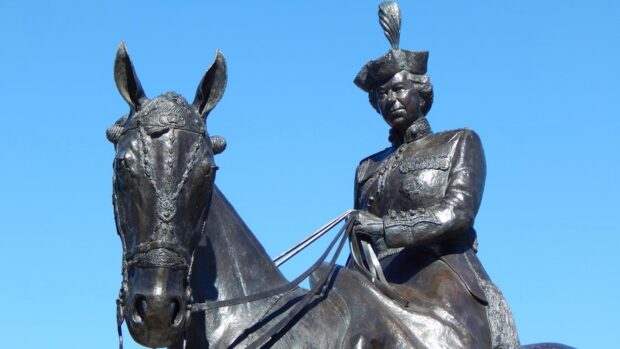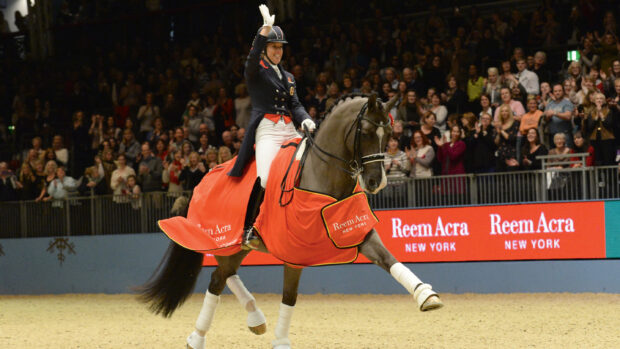Love for four-legged friends runs deep in the horse world – whether those legs end in hooves or paws. They are our companions, we adore them, we want to do the best for them, always.
Which is why we need to have a re-think about what is in the best interests of both dogs and horses at events.
Tom McEwen’s cross-country fall at the Longines Luhmühlen Horse Trials is a wake-up call nobody wanted.
I am not suggesting a ban on dogs at fixtures. But we need to reassess how they are there for everyone’s sake – four-legged and two.
Tom and Bob Chaplin were on their final approach to the penultimate question on Mike Etherington-Smith’s five-star course – a brush corner at 29a (Kombination “Close to Home”) when a dog on an extendable lead ran on to the track.
“I found my line to the corner and then I could hear the extendable lead extending, with this lady screaming at a dog. Sadly the line is so tight, the dog came from Bob’s right side so it pushed him further out left and that put him into the corner,” Tom told me on Saturday.
“Horses at that point in the course are tired and they are also unbelievably honest and love what they are doing. Bob, being Bob, went, ‘I can do it’ and just jumped in. Sadly for him we went into the widest part of the corner all because a dog came in and popped him off his line.”
This was not the interview I wanted to be having with Tom, nor the one I was mentally preparing in my mind as I watched him to that point. Their round stood out because of how carefully Tom was building the horse’s confidence, fence by fence, on Bob’s first attempt at this level. Tom’s skill in allowing the horse to understand each question, rewarding him when he answered, and how Bob seemed to blossom and grow as the course progressed was beautiful to watch.
After their dressage, I watched as Bob tucked into a packet of Polos with relish – delighted at the fuss from his connections. The thought of his team waiting almost certainly with more Polos at the finish line, only for that to happen, makes me choke at the desperate unfairness of the situation.
I saw Tom’s fall on the live-feed by the cross-country finish area, and saw him get up and throw his hands in the air in apparent frustration, clearly not at the horse, but something else. Rumours about a dog then started to filter through. I knew I needed to speak to him to find out the facts and to stop dead any speculation, given the penalties would go on the horse’s record and because our readers – like me – would have seen his out-of-character reaction on the live-stream, without the context of what caused it.
“It’s probably the first time that I’ve properly been angry in a long time, but I just felt gutted for the horse, for the owners and everyone involved because he was a star and didn’t deserve that from a dog running on to the course on an extendable lead,” Tom told me, adding his main concern was that the horse was alright.
Eventing is a risk sport and the volume of work and research that goes into minimising those risks is vast. Every inch of the ground, the water and the fences on that course will have been designed and prepared to strict standards. There are strict rules about riders’ protective equipment for a reason, too, and horse welfare is the absolute priority of all involved in the sport. Which is why dog-related incidents are so frustrating.
They are also not isolated incidents – who hasn’t heard tannoy announcements about loose dogs at events? H&H has written countless stories over the years about dogs chasing horses on course at fixtures and the FEI introduced CHF100 (£84) fines in 2019.
So what is the answer?
Aside from banning dogs at events, which would be a shame and questionably workable, perhaps there are some simple things that I believe could prevent dog-related incidents:
- No extendable leads. Keep them at home and use a short lead at events. Forgotten one? Buy one.
- Properly fitted harnesses, unless there is a legitimate veterinary reason that they cannot be worn, to prevent dogs slipping their collars
- £1,000 fine – to charity – if your dog is on course (loose, or otherwise) while the field of play is live. £2,000 for repeat offenders
Accidents happen, no dog owner would do this on purpose, and I’m certain those it has happened to feel absolutely terrible.
We as a sport have a responsibility to look after each other and the animals involved. There needs to be action and accountability before a rider, an adored horse or a beloved dog is hurt.
Thankfully Tom and the horse were both fine; looking at the way the horse had jumped to that point, he is incredibly exciting for the future at this level.
But the point remains that this should never have happened. From a safety, welfare and sporting perspective, this kind of incident must stop.
Dogs love walks in the park. They also love tennis balls, but that doesn’t mean a certain quota of loose dogs is accepted, with an eye-roll, at Wimbledon each year. So why are they in horse sport?
- What do you think? Send your thoughts to hhletters@futurenet.com, including your name, nearest town and country, to be considered for the letters’ page in a forthcoming issue of the magazine
You might also be interested in:

‘This is why I hate extendable dog leads’: mixed fortunes for Brits on Luhmühlen cross-country day

Top eventer chased by loose dog asks: ‘Why didn’t they ring the bell?’
The dog was at the rider’s heels as he took on the CCI3* showjumping

Top eventer jumps clear despite loose dog at his heels
The rider praised his young horse, who stayed focused to jump a clear on holding ground

Horse and rider chased on cross-country by loose dogs in terrifying ordeal
“It could have ended up with two dead dogs, or a serious if not fatal injury to horse and rider”

Subscribe to Horse & Hound magazine today – and enjoy unlimited website access all year round
Horse & Hound magazine, out every Thursday, is packed with all the latest news and reports, as well as interviews, specials, nostalgia, vet and training advice. Find how you can enjoy the magazine delivered to your door every week, plus options to upgrade your subscription to access our online service that brings you breaking news and reports as well as other benefits.




